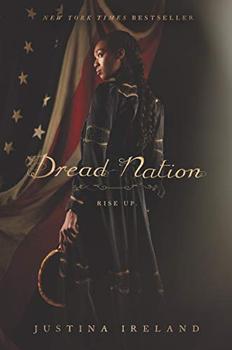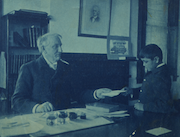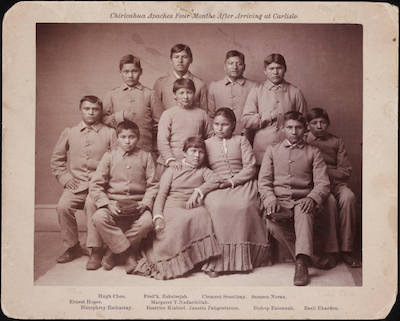Summary | Excerpt | Reviews | Beyond the Book | Read-Alikes | Genres & Themes | Author Bio

This article relates to Dread Nation
 The boarding school in Dread Nation, where children are sent after being taken from their families is based on real schools that existed across the United States. While Miss Preston's, the school in Dread Nation is specifically for girls of color to be combat-trained to fight zombies, in other respects it resembles the Native American boarding schools of the 19th and early 20th centuries. From as early as 1677 settler communities, and then later the United States government, ran boarding schools that were intended to "civilize" indigenous youth through a regulated process of forced assimilation. One of the most infamous of these schools, which informed the author's conception of Miss Preston's, was the Carlisle Indian Industrial School, established in 1879 by Captain Richard H. Pratt in Carlisle, Pennsylvania. It is now the US Army's Carlisle Barracks.
The boarding school in Dread Nation, where children are sent after being taken from their families is based on real schools that existed across the United States. While Miss Preston's, the school in Dread Nation is specifically for girls of color to be combat-trained to fight zombies, in other respects it resembles the Native American boarding schools of the 19th and early 20th centuries. From as early as 1677 settler communities, and then later the United States government, ran boarding schools that were intended to "civilize" indigenous youth through a regulated process of forced assimilation. One of the most infamous of these schools, which informed the author's conception of Miss Preston's, was the Carlisle Indian Industrial School, established in 1879 by Captain Richard H. Pratt in Carlisle, Pennsylvania. It is now the US Army's Carlisle Barracks.
In their many iterations, these schools operated on the sentiment "kill the Indian and save the man," well before this remark was read at a convention by Capt. Pratt in 1892. The earliest schools were offshoots of missions in settler communities where local native communities would send children to be educated and, in European eyes, civilized. These were followed by boarding schools on reservations themselves from 1860 onwards, first on the Yakima Indian Reservation in Washington State, where they were intended to solve "the Indian Problem" through education-based assimilation. However, as American expansion continued, on-reservation schools were not considered aggressive enough, and the Carlisle Indian Industrial School became the model for the over 150 schools later opened by the Bureau of Indian Affairs.
 At these schools, the practice was to strip away any and all bits of culture from the children who were sent there. Their names were changed, their hair was cut, they were forbidden their languages and traditional practices. Conversion to Christianity, and adoption of white food culture and history, and even the imposition of surnames was common, if not required. Those who did not comply faced strict punishments, including food deprivation and corporeal punishment. There were "out-placement" programs as well – hard labor on local farms resembling chattel slavery. Gender equality, which was promoted within many Native tribes, was replaced with white men's vision of the distinctive - and unequal - roles of men and women.
At these schools, the practice was to strip away any and all bits of culture from the children who were sent there. Their names were changed, their hair was cut, they were forbidden their languages and traditional practices. Conversion to Christianity, and adoption of white food culture and history, and even the imposition of surnames was common, if not required. Those who did not comply faced strict punishments, including food deprivation and corporeal punishment. There were "out-placement" programs as well – hard labor on local farms resembling chattel slavery. Gender equality, which was promoted within many Native tribes, was replaced with white men's vision of the distinctive - and unequal - roles of men and women.
While some children were taken forcibly from their homes and families, it should also be noted that the systematic oppression of Native Americans also meant that in many cases the boarding schools were the only options for families. While many of these schools have been shut down, in some places they remain, to this day, the only option for education on or near certain reservations, and so ironically some tribal nations are fighting to keep them open.
 The legacy of these schools scarred many nations and many people and has arguably not only contributed to the decline and disenfranchisement of Native Americans but could be considered genocidal in intention. It is a part of the country's history that should be more closely examined and questioned.
The legacy of these schools scarred many nations and many people and has arguably not only contributed to the decline and disenfranchisement of Native Americans but could be considered genocidal in intention. It is a part of the country's history that should be more closely examined and questioned.
From 1879 until 1918, over 10,000 Native American children from 140 tribes attended Carlisle.
General Pratt and a student at Carlisle.
Pratt's before and after "contrast" photos were sent to officials in Washington, to potential charitable donors and to other reservations to recruit new students.
Filed under People, Eras & Events
![]() This "beyond the book article" relates to Dread Nation. It originally ran in May 2018 and has been updated for the
June 2019 paperback edition.
Go to magazine.
This "beyond the book article" relates to Dread Nation. It originally ran in May 2018 and has been updated for the
June 2019 paperback edition.
Go to magazine.
The whole problem with the world is that fools and fanatics are always so certain of themselves, and wiser people ...
Click Here to find out who said this, as well as discovering other famous literary quotes!
Your guide toexceptional books
BookBrowse seeks out and recommends the best in contemporary fiction and nonfiction—books that not only engage and entertain but also deepen our understanding of ourselves and the world around us.